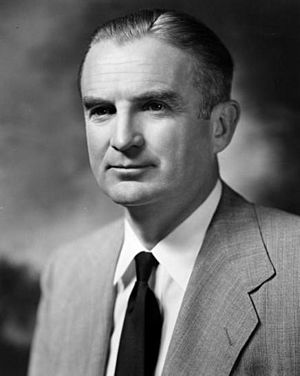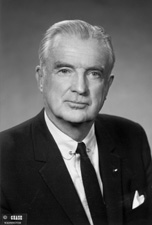Stuart Symington facts for kids
Quick facts for kids
Stuart Symington
|
|
|---|---|
 |
|
| United States Senator from Missouri |
|
| In office January 3, 1953 – December 27, 1976 |
|
| Preceded by | James P. Kem |
| Succeeded by | John Danforth |
| 1st United States Secretary of the Air Force | |
| In office September 18, 1947 – April 24, 1950 |
|
| President | Harry S. Truman |
| Preceded by | Position established |
| Succeeded by | Thomas K. Finletter |
| Personal details | |
| Born |
William Stuart Symington III
June 26, 1901 Amherst, Massachusetts, U.S. |
| Died | December 14, 1988 (aged 87) New Canaan, Connecticut, U.S. |
| Political party | Democratic |
| Spouses |
Evelyn Wadsworth
(m. 1924; died 1972)Ann Hemingway Watson
(m. 1978) |
| Relatives | Symington family |
| Education | Baltimore City College Yale University (BA) |
| Military service | |
| Allegiance | United States |
| Branch/service | United States Army |
| Years of service | 1918–1919 |
| Rank | |
| Unit | 84th Division |
| Battles/wars | World War I |
William Stuart Symington III (born June 26, 1901 – died December 14, 1988) was an important American politician and businessman from Missouri. He was a member of the Democratic Party.
Symington made history as the very first Secretary of the Air Force. He held this job from 1947 to 1950. Later, he served as a United States Senator for Missouri from 1953 to 1976.
Born in Amherst, Massachusetts, Symington worked in different companies. He became the president of Emerson Electric, a big manufacturing company. After his business career, he joined President Harry S. Truman's government.
In the Senate, he became known for his work on military issues. He also spoke out against McCarthyism, which was a time when people were unfairly accused of being Communists. Symington even ran for president in 1960, but he did not win the nomination.
Contents
Early Life and Career
Growing Up and Education
Stuart Symington was born in Amherst, Massachusetts. His father was a professor and later a federal judge. Stuart grew up in Baltimore, Maryland, as the oldest of five children.
He went to public school and a private school called the Gilman School. In 1918, at just 17 years old, he graduated from Baltimore City College. Soon after, he joined the United States Army during World War I.
Military Service and College
Symington trained as an officer at Camp Zachary Taylor. The war ended before he could be sent to fight overseas. He became one of the youngest second lieutenants in the Army before leaving in 1919.
After his military service, he went to Yale University and graduated in 1923. At Yale, he was involved in student groups and the Yale Daily News newspaper. In 1924, he married Evelyn Wadsworth. They had a very happy marriage.
Business Success
After college, Symington started working for his uncle's company, which made iron products. He then started his own company, Eastern Clay Products. He later became president of Colonial Radio Corporation.
In 1938, Symington became the president of Emerson Electric Company in St. Louis, Missouri. During World War II, he helped transform the company. It became the world's largest maker of airplane gun turrets. Symington also believed in fairness for all people. He made sure that people of all races could work at Emerson Electric. This helped the company become even more productive.
First Secretary of the Air Force
Leading the New Air Force
In 1945, Symington left Emerson Electric to work for President Harry S. Truman. He held several important roles in the government. On September 18, 1947, a new government position was created: the Secretary of the Air Force. Symington became the very first person to hold this job.
His job was to help the United States Air Force become a strong and respected branch of the military. Before this, the Air Force was part of the Army. He worked hard to make sure the Air Force got the respect and funding it needed.
Key Decisions and Achievements
During his time as Secretary, Symington faced challenges. He had disagreements with the Secretary of Defense about funding. One big decision involved the YB-49 Flying Wing bomber project. Symington decided to cancel this project and ordered the existing aircraft to be destroyed.
Important achievements during his term included the Berlin Airlift. This was a huge effort to fly supplies into West Berlin when the Soviets blocked land routes. He also strongly supported creating the United States Air Force Academy. Symington resigned in 1950 because he felt the Air Force was not getting enough money after the USSR developed its own nuclear weapon.
Serving as a U.S. Senator
Becoming a Senator
In 1952, Stuart Symington decided to run for the United States Senate in Missouri. He won the election, taking a seat that had been held by former President Truman. He was re-elected three more times, serving until 1976.
Focus on National Defense
As a Senator, Symington joined important groups like the Senate Armed Services Committee and the Foreign Relations Committee. He became an expert on military matters. He always pushed for a strong national defense for the United States. He also continued to be a strong supporter of the Air Force Academy.
Symington was also a critic of the Vietnam War. He believed the U.S. was wasting money on outdated weapons. He learned a lot about secret operations during the Laotian Civil War.
Standing Up to Joseph McCarthy
Symington was a strong opponent of Senator Joseph McCarthy. McCarthy was known for accusing people of being Communists without much proof. Symington spoke out against McCarthy's methods.
In one famous case, Symington defended a woman named Annie Lee Moss. She was accused of being a Communist spy. Symington believed she was innocent and publicly stated it. Later, he played a key role in criticizing McCarthy during the Army–McCarthy hearings.
Running for President
In 1959, Symington prepared to run for president in the 1960 United States presidential election. He had the support of former President Harry Truman. However, he eventually lost the nomination to Senator John F. Kennedy.
Symington chose not to campaign in the primary elections. This allowed Kennedy to gain a strong lead. Symington also refused to speak to segregated groups in the southern United States. This decision hurt his chances of winning the nomination. He was considered for Vice President but the spot went to Lyndon B. Johnson. Symington later advised President Kennedy during the Cuban Missile Crisis in 1962.
Supporting Civil Rights and Sports
Symington was a strong supporter of Civil Rights. He voted for important laws like the Civil Rights Acts of 1957, 1960, 1964, and 1968. He also supported the Voting Rights Act of 1965.
He also helped bring the Kansas City Royals baseball team to Missouri. When the Kansas City Athletics team moved to Oakland, Symington threatened to change laws that protected Major League Baseball. This pressure helped Kansas City get a new team.
Leaving the Senate
In 1976, Symington decided not to run for re-election. He resigned a week before his term officially ended. This allowed his successor, John Danforth, to gain more seniority in the Senate.
Legacy and Family
In 1962, Symington received the James Madison Award for Distinguished Public Service. This award recognized his long and important career.
His son, James W. Symington, also served in the United States House of Representatives. His cousin, Fife Symington III, was the Governor of Arizona. His grandson, Stuart Symington, has served as a U.S. ambassador to several countries.
Stuart Symington retired in 1978 and passed away on December 14, 1988. He is buried in the Washington National Cathedral.
See also
- Symington Amendment


